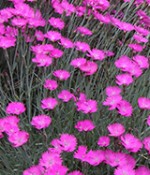 Dianthus is a genus in the carnation family, Caryophyllaceae, and includes sweet william and pinks. Most of the species are annuals , biennials, or herbaceous perennials and are native to Europe and Asia but a few come from North Africa. Most garden species form low mats or bushy rosettes of foliage and have pairs of green, gray-green or blue-green grassy leaves covering a swollen node at the base. Five petaled flowers appear on wiry stems singly, or in clusters of 2 or more in spring or summer. The flowers of most species have a spicy scent, are usually white, pink, or red, and are frilled, fringed, or toothed at the apex. The generic name, Dianthus, comes from the Greek words dios, meaning divine, and anthos meaning flower.
Dianthus is a genus in the carnation family, Caryophyllaceae, and includes sweet william and pinks. Most of the species are annuals , biennials, or herbaceous perennials and are native to Europe and Asia but a few come from North Africa. Most garden species form low mats or bushy rosettes of foliage and have pairs of green, gray-green or blue-green grassy leaves covering a swollen node at the base. Five petaled flowers appear on wiry stems singly, or in clusters of 2 or more in spring or summer. The flowers of most species have a spicy scent, are usually white, pink, or red, and are frilled, fringed, or toothed at the apex. The generic name, Dianthus, comes from the Greek words dios, meaning divine, and anthos meaning flower.
The plants like full sun, average, medium moist to dry, well-drained soil with a neutral or slightly alkaline pH. Propagation is by seed, division, and terminal cuttings. Plants are short lived and should be divided every 2-3 to keep them vigorous. Deadhead to keep plants in bloom for up to 6 weeks. Low growing species are excellent for the front of the garden or used as a ground cover. Dwarf species do well in rock gardens or wall gardens while lager species combine well with other perennials in borders. Many are excellent cut flowers.
The following Dianthus are recommended for the garden:
Cottage Pink (D. x allwoodii)
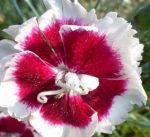 With single to double flowers in clusters of 2, this hybrid has many good cultivars such as ‘Doris’ (salmon pink), ‘Dainty Maid’ (purple), and ‘Essex Witch’ ( pinks, white, salmon).
With single to double flowers in clusters of 2, this hybrid has many good cultivars such as ‘Doris’ (salmon pink), ‘Dainty Maid’ (purple), and ‘Essex Witch’ ( pinks, white, salmon).
Type: Perennial
Height: 12-20″
Flower Color: White, pink, red, purple
Foliage Color: Bluish gray
Bloom Time: Summer for up to 6 seeks
Hardiness: Zones 4-8
Alpine Pink (D. alpinus)
 One inch long leaves for a loose matted clump that has 1.5 ” wide fringed, scentless flowers.
One inch long leaves for a loose matted clump that has 1.5 ” wide fringed, scentless flowers.
Type: Perennial
Height: 3-6″
Flower Color: Pink with white central disc
Foliage Color: Grass green
Bloom Time: Late spring
Hardiness: Zones 3-7
Sweet William (D. barbatus)
 Unscented toothed or fringed flowers are arranged in distinctive flat topped clusters; reseeds readily.
Unscented toothed or fringed flowers are arranged in distinctive flat topped clusters; reseeds readily.
Type: Biennial
Height: 10-24″
Flower Color: White, pink, red, maroon sometimes with eye
Foliage Color: Green
Bloom Time: Late spring
Hardiness: Zones 3-9
Annual Pink (D. chinensis)
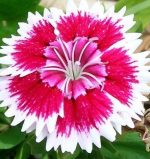 A beautiful plant with deeply toothed flowers but poor tolerance. of heat and humidity. Hybrids from a crossing with D. barbatus has yielded many excellent cultivars that combine long bloom time with heat tolerance.
A beautiful plant with deeply toothed flowers but poor tolerance. of heat and humidity. Hybrids from a crossing with D. barbatus has yielded many excellent cultivars that combine long bloom time with heat tolerance.
Type: Annual
Height: 12-15″
Flower Color: Pink to lilac with a purple eye
Foliage Color: Green
Bloom Time: Summer
Hardiness: Zone 8 maximum
Maiden Pink (D. deltoides)
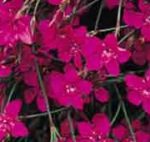 Loose wide mats of small linear leaves sport fragrant solitary 3/4′ wide flowers over long bloom period.
Loose wide mats of small linear leaves sport fragrant solitary 3/4′ wide flowers over long bloom period.
Type: Perennial
Height: 6-12′
Flower Color: Red, rose
Foliage Color: Green with rosy flush in cool weather
Bloom Time: Summer
Hardiness: Zones 3-9
Cheddar Pink (D. gratianopolitanus)
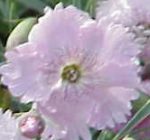 Narrowly lanceolate foliage forms compact tussocks with 1″ wide fragrant flowers singly or in 2s.
Narrowly lanceolate foliage forms compact tussocks with 1″ wide fragrant flowers singly or in 2s.
‘Firewitch’ is an especially good cultivar in warm climates but many good cultivars are available.
Type: Perennial
Height: 9-12″
Flower Color: Various shades of pink
Foliage Color: Gray-green
Bloom Time: Spring
Hardiness: Zones 3-9
Hardy Garden Pink (Dianthus knappii)
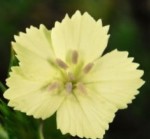 Two to three inch long leaves accompany clusters of 8-10 3/4 ” wide, unscented flowers that bloom for 4-6 weeks. Although the flower color is unusual for the genus it is pale and not eye catching.
Two to three inch long leaves accompany clusters of 8-10 3/4 ” wide, unscented flowers that bloom for 4-6 weeks. Although the flower color is unusual for the genus it is pale and not eye catching.
Type: Perennial
Height: 15-24″
Flower Color: Pale yellow
Foliage Color: Pale grayish green
Bloom Time:Summer
Hardiness: Zones 3-8
Cottage Pink (Dianthus plumarius)
 This species is similar to D. gratianapolitanus but can be distinguished by its more deeply cut petals and its flowers being groups in 2s.
This species is similar to D. gratianapolitanus but can be distinguished by its more deeply cut petals and its flowers being groups in 2s.
Type: Perennial
Height: 18-24″
Flower Color: Pink
Foliage Color: Gray-green
Bloom Time:Early summer
Hardiness: Zones 3-9